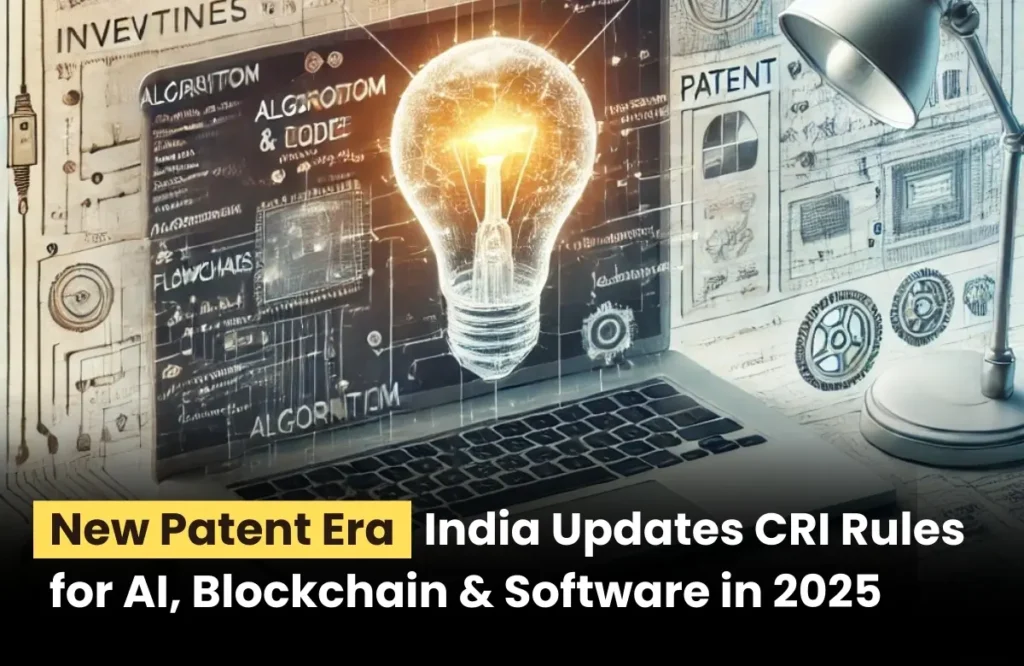
The Indian Patent Office (IPO) introduced the revised 2025 guidelines for Computer-Related Inventions (CRIs) on July 29, marking a significant step in modernizing India’s patent framework. The objective of these guidelines is to address long-standing uncertainty for software patents, artificial intelligence (AI), blockchain, and other emerging technologies, aiming to bring India’s patent practice more in line with international standards.
Background of India’s CRI Guidelines 2025 | Software Patent Rules
If you are wondering why India even needed fresh CRI guidelines, the answer lies in a specific provision of Indian patent law. Under Section 3(k) of the Patents Act, ideas like mathematical formulas, business processes, pure software codes, or standalone algorithms are not allowed to be patented because, according to the above section, they lack patentability. In simple terms, writing a program or an algorithm by itself is not enough to earn patent protection in India.
What is required instead is a practical application of that software or algorithm. For instance, if a new AI model is embedded into a device, a unique hardware setup, or produces a clear technical benefit—like reducing processing time, saving energy, or making a system more secure—then it could fall within the scope of patent protection.
But imagine a world where even a small piece of code, an algorithm, or a simple program has the power to transform industries. In the era of artificial intelligence, this is no longer a far-fetched idea—it’s reality.
CRI Guidelines 2025: What Changed and Why It Matters
The Indian Patent Office’s new CRI Guidelines 2025. These rules are meant to make things clearer for people applying for patents in fields like Machine learning, artificial intelligence (AI), cloud technology, blockchain, and quantum computing.
Here are the main updates in simple words:
Clearer Rules for Checking Patents
Patent officers now have a step-by-step process to check whether an invention is new and truly inventive. This makes the system more fair and less confusing for applicants.
Software Alone is Not Enough
For software, code, or algorithms to be patentable, the invention must show a real technical benefit—for example, faster processing, better security, saving memory, or controlling a device.
Real Examples to Guide Everyone
The guidelines now include around 60 examples (20 in the main document and 40 in an annex). With these examples now, it will be easier in future cases for both parties, individuals, and examiners to determine which tech can be patented and which can’t.
Stronger Legal Backing
The rules are now linked to important court decisions in India. This helps both inventors and examiners by giving them legal clarity on what counts as a valid invention. It also makes it clear that AI on its own cannot be an inventor, but AI-assisted inventions can still qualify if they bring real innovation.
Special Focus on New Tech
A dedicated section explains how patents will be handled in AI, machine learning, deep learning, blockchain, quantum computing, and cloud systems. This is important because these are fast-growing fields where the line between “idea” and “invention” is often blurred.
How the CRI Guidelines 2025 Will Shape India’s Software Industry
The CRI Guidelines 2025 are set to reshape India’s software industry by giving clear rules on what can and cannot be patented. This will boost innovation, as startups and developers gain more confidence to work on AI, machine learning, blockchain, cloud, and quantum computing projects. Genuine inventions that show a technical effect—such as faster speed, better security, or higher efficiency—will now stand a stronger chance of protection, ensuring creators can safeguard their work. At the same time, the guidelines bring India closer to global practices, attracting foreign investors, while also preventing monopolies over pure software or algorithms. This creates a fairer and more competitive environment for both established companies and new entrants.
What We Can Expect in the Future
- More Patents in Emerging Tech: Expect a rise in patent filings around AI, machine learning, blockchain, and cloud-based platforms.
- Growth of Deep-Tech Startups: Startups building innovative tools (health-tech AI, fintech blockchain, etc.) will thrive under clearer IP protection.
- Stronger Global Partnerships: Indian companies will collaborate more with global R&D centers, as India’s IP system gets more recognition.
- Push for Hardware-Software Integration: Since standalone software isn’t patentable, companies will focus on building practical applications that combine software with real-world systems.
Read Also: What are the Benefits of Patent Monetization
Conclusion
The CRI Guidelines 2025 mark a key step for India, protecting genuine tech innovations while ensuring fair competition in the software industry. They bring India’s patent system closer to global standards, offering clarity for inventors and examiners alike. In the long run, these rules will encourage startups, attract investment, and strengthen India’s position as a global technology hub.









